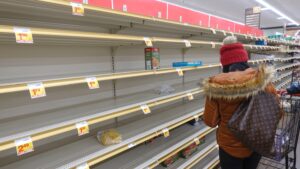Q: Why so many product shortages? A: The Perfect Storm

I have had a number of calls this past week with various media outlets, including the Associated Press, WRAL, Forbes, and even the New York Times! All of these reporters are asking the same question, which was best captured by a reporter at Forbes: “How is it that in a modern economy like the United States, where we have plenty of capital and strong demand, that we can’t buy the things we need?” This is indeed a compelling question – but the answer is a bit more complicated than you might think.
Think of the film that came out a few years ago: “The Perfect Storm“, which describes how a boat in Massachusetts was lost at sea. The storm was a nor’easter that absorbed Hurricane Grace, and ultimately evolved into a small unnamed hurricane itself late in its life cycle. The comparison to the current state of product supply chains is an appropriate one, as the root cause of these shortages cannot be attributed to a single event, but rather to a multitude of different events that coincided with one another at the same time, (or at least in the same period of time), which resulted in a domino effect that is causing all of the problems.
I disagree 100% with the Fed Chairman’s assessment last week in Jackson Hole that supply chain problems are a short-term temporary issue. I’ve been saying for some time that inflation and shortages are likely to continue for some time. Fed Chairman Powell dismissed the fastest runup in prices in years with a wave of his hand: “So far largely the product of a relatively narrow group of goods and services that have been directly affected by the pandemic and the reopening of the economy.” He argued that all of this price inflation will soon pass as supply constraints ease. This assessment is dead wrong in my opinion, and we are likely to continue to see high prices and plenty of constraints (including automobile markets) that will be unrelenting for some time to come. At least that’s my two cents.

Why? Let’s start with COVID. We all know by now how the semiconductor shortage occurred when the automotive industry failed to order enough chips, which led the semiconductor industry to reduce their capacity. When demand instead peaked for vehicles and electronics, this came as a surprise. One can’t start producing chips quickly after shutting down a fab, and adding new fab plants is a significant investment, often involving billions of dollars and years to put into place. As a result, chips will likely not catch up with demand until late 2022, and this will continue to impact not just automobiles, but virtually every electronic product you can think of. Even Apple is reporting that they are seeing shortages of chips for their phones and products.
COVID has also hit a number of key ports, like the port of Yantian, which is a major outbound port for shipping products to the US. Once a port shuts down, ships and containers back up, and this bottleneck is difficult to catch up with. There are also periodic port closures in other parts of the world, again due to the proliferation of the Delta variant. or containerized imports, I’ve already spoken about the major container shortages, the shutdown of the Chinese port in Shenzhen, and the longer dwell times in ports, that is resulting in container prices jumping to $6300 and sticking there. This is driving up costs of imports from China. And many US ports are slowing down, because of the labor shortage! There aren’t enough workers to unload the ships. Then there are the container issues. The problem with containers is that most of them are stuck in the US, but need to be at ports and manufacturers in China! For the first time in the rail container volume index history, non-holiday empty containers outnumber the loaded container volumes heading into Los Angeles. This occurred briefly at the beginning of 2019 around New Year’s when the trade war with China was escalating. Empty international containers are controlled mainly by the maritime operators and can signal growth in import volumes. This one, however, may just illustrate how dire the situation really is.
Hurricane Ida and the big Texas freeze are important elements of the perfect storm. Prices for polyethylene, polypropylene and other chemical compounds used to make auto parts, computers, and a vast array of plastic products, have reached their highest levels in years in the U.S. as supplies tighten. Not only were the petrochemical plants shut down, but many also had to order parts that were damaged in the storm, which in some cases had long manufacturing lead times of 30 days or more. The supply of resins that impacted a number of different products we take for granted, like packaging, plastic injection molded parts, and other materials that are used across a number of different industries. When Ida hit the southwestern Louisiana coast, all we know is that those plants were evacuated, and many of them have no power, and may not have power for several days or possibly weeks. This is going to make an already problematic situation for resins even worse… which means more shortages. Resin shortages are hitting healthcare manufacturers who use them for tubing, plastic components, and other parts used in many products.
What about steel? Structural steel right now has prices that are through the roof (literally, as steel beams are typically used for framing new DC and warehouse structures). The growth in warehouse construction has led to massive demands for structural steel, and especially bar joists. Normally bar joist lead times are historically 12 to 14 weeks, depending on the region. Today, they are out to 32 to 50 weeks! This varies by region. In areas like the Mid-West that are not as busy, you can get bar joists in 32 weeks. If you are buying them in Florida, the Southeast, or New Jersey, lead times are well north of 40 weeks, and likely closer to 50. This is a major disruptor to capacity expansion plans. And prices for bar joists (which are generally unpublished) have gone up 300%. Prices are unpublished, as typically fabricators will send out drawings based on an architectural plan and specifications, and our sources suggest prices have escalated from $1200 a ton to $4000 a ton today…Aluminum prices have also been rapidly escalating (Figure 6), and have steadily increased by 73% since March 2020 from $1426 to $2476 in June 2021. Today it closed at $2497, the highest it’s been in 10 years. This level of price escalation has never been seen in the industry, based on our discussions with experts. Copper is also at an all time high. So the basic building blocks for construction, beer and soda cans, electrical products, etc. are going up everywhere.
All of these shortages are hitting manufacturing. I tried to order a fridge in August, and was told that delivery would be sometime in December… if I’m lucky. Trying to buy any type of appliance, bicycle, or other product today is a hit and miss attempt. What this means, is that people have money they are able to spend, but having trouble finding the products they want to spend it on! Bindya Vihali, CEO of Resilinc, believes that the shortages are due to people “over ordering”: It’s six months of extremely painful constraints fueled by holiday season demand surge, an artificially inflated demand signal from everyone ditching lean / JIT and trying to over order in a constrained supply environment. And the natural annual pattern of the second half being generally more disruptive than first half of the year. How much of the current demand is TRUE demand vs. over ordering by panicked procurement professionals?
In my opinion, what we are seeing are true shortages, coupled with excess demand. I also believe that holiday season is going to leave a lot of kids with a backorder ticket in their stocking, as I don’t believe supply chains will recover in time for Christmas. This could also result in some downtrodden financial earnings due to inflation and lack of revenue due to shortages of product… which could lead to a very different economic picture. Don’t mean to be a downer, but I believe these shortages are likely going to last through the better part of 2022, and likely into 2023. A much less rosier picture than the Fed.
What can executives do? Sales and Operations planning is something that can help, and having realistic views of what you can promise and deliver to markets is an important part of advance planning. However, there may be little that can be done about supply shortages. It helps to have realistic forecasts. Forecasting isn’t easy if demand is so unstable, and you cannot easily forecast demand using common forecasting time series models. The answer is that one needs to start using consumption-based forecasting, and using real consumer consumption data to better understand what is happening, and then seeking to connect it to other events through econometric or event-planning data, using outlier analysis. By building more robust and realistic plans in the face of the likely continued shortages, supply chain managers can find ways to deal with a difficult situation and try to make the best of it.


